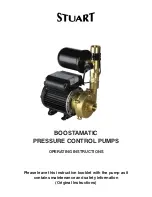
-
INSTALLER
HIGH-TEMPERATURE ENERGY EFFICIENT HEAT PUMP
MANUAL
-
57
0945
-
1830
frost pt.
1830
-
2400
eco
A6.1 - Preparing the hydraulic circuit
(rinsing)
A6.2 - Water for fi lling
A6.3 - Heating circuit treatment
Press dial to quit viewing
programming for given day.
A6 - Heating circuit water treatment
Before installing the HRC
70
Pilot and HRC
70
Heat Pump, the
installation must be rinsed with a suitable product.
This helps to eliminate all traces of soldering waste, grout, grease,
sludge, metallic particles etc. in radiators, underfl oor heating etc.
This prevents any of the abovementioned waste getting into the
HRC
70
Heat Pump heat exchanger or blocking the fi lter which is
fi tted on the incoming water inlet.
Several diff erent types of material are used to make a heating
circuit. Instances of corrosion may occur through galvanic
coupling in new and old installations alike.
The water circuit must only be fi lled using untreated (unsoftened)
water from the drinking water circuit.
If water from any
other source (e.g. a well or a drill-hole) is used, the
warranty is rendered null and void.
We would recommend the use of SENTINEL products for
preventative and curative heating water circuit treaatment.
• Fitting the appliance onto new installations (under 6 months)
- Clean the installation with an all-purpose cleaning product to
eliminate installation debris (copper, fi bres, soldering waste), for
example SENTINEL X300 or SENTINEL X800
- Rinse the installation thoroughly until the water is clear and
completely free of impurities.
- Protect the installation from corrosion with an inhibitor (for
example SENTINEL X100), or from corrosion and frost with an
inhibitor and antifreeze agent (for example SENTINEL X500 or
SENTINEL R600).
• Fitting the appliance onto existing installations
- De-sludge the installation with a product for eliminating sludge
from the installation (for example SENTINEL X400 or SENTINEL
X800).
- Rinse the installation thoroughly until the water is clear and
completely free of impurities.
- Protect the installation from corrosion with an inhibitor (for
example SENTINEL X100), or from corrosion and frost with an
inhibitor and antifreeze agent (for example SENTINEL X500 or
SENTINEL R600).
Treatment products from other manufacturers may be used if they
guarantee suitability to all the materials used in the installation and
they off er eff ective corrosion resistance.
In cases where the HRC
70
Heat Pump cannot run (outdoor
temperature outside the operating range) if a back-up source
is authorised to run (boiler or electrical) it will automatically
be protected from frost and ice because the circulator pump
will run and extract heat from the heating circuit, which has its
temperature maintained either by the HRC
70
Pilot electrical back-
up or by boiler back-up.
However, in case of installation without a back-up source or the
Heat Pump or Pilot being switched off during the winter period
(e.g: stopping accidentally, use in a second home etc...), it will be
necessary to provide additional protection against frost and ice
so that you do not need to drain the Heat Pump’s hydraulic circuit
which is situated outside the building.
Monopropylene glycol
should be used as an anti-freeze agent
with an added corrosion inhibitor.
A6.4 - Frost protection
Choose the % of glycol according to the minimum outside
temperature to protect the water circuit from ice (it should not be
less than 25%):
Outdoor temperature (°C)
-10
-15
-20
-25
% of glycol needed
25
30
35
40
Do not use mono-ethylene glycol (toxic
product)
Central heating installations MUST BE
CLEANED to eliminate debris (copper, fi bres,
soldering waste) which can come from setting up
the installation or from chemical reactions between
metals.
Furthermore, it is important to PROTECT CENTRAL
HEATING INSTALLATIONS FROM RISKS OF
CORROSION, LIMESCALE AND MICROBIOLOGICAL
DEVELOPMENT
by using a corrosion inhibitor which
is suitable for all types of installations (steel radiators,
cast iron, PEX underfl oor heating).
PRODUCTS USED FOR HEATING WATER
TREATMENT MUST BE APPROVED BY YOUR LOCAL
OR NATIONAL PUBLIC HYGIENE AND HEALTH
AUTHORITY.
The corrosion inhibitor:
- limits limescale formation
- prevents ‘‘pinhole’’ corrosion
- prevents sludge accumulation and the spread of bacteria in
new installations (algae in low-temperature circuits)
- prevents hydrogen formation
- eliminates noise from generators
















































